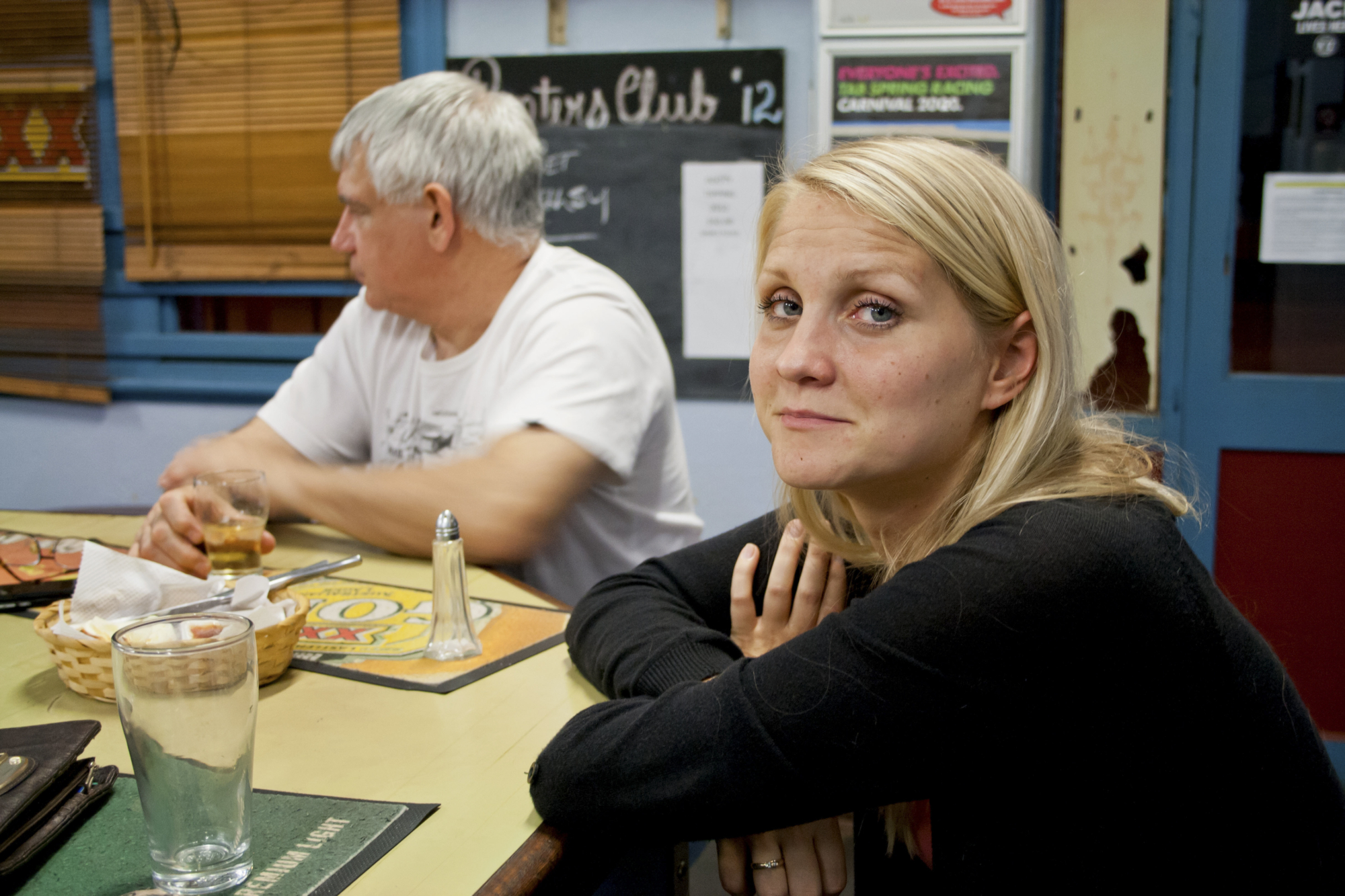Zooming into an abstract landscape of raw umber, burnt sienna and coal-grey on Google Maps, three yellow highway lines finally make themselves clear. The town of Coolgardie, Western Australia – population: 1000 – appears in an immaculate grid at the juncture of the Great Eastern and Coolgardie-Esperance highways. We are at the unmarked tri-border of the Wangkathaa, Kalaamaya and Malpa Indigenous nations.[1]See the Australian Institute of Aboriginal and Torres Strait Islander Studies map of Indigenous Australia, <http://aiatsis.gov.au/explore/articles/aiatsis-map-indigenous-australia>, accessed 4 November 2016. On the main strip is a Caltex, an IGA X-Press and, on the corner, the Denver City Hotel. A former gold-rush town, Coolgardie is more than 500 kilometres east of Perth and half an hour from the mining centre of Kalgoorlie, the largest settlement for many more hundreds of kilometres.
At the 2016 Sydney Film Festival (SFF), Pete Gleeson, the director of the recent Australian documentary Hotel Coolgardie – which premiered earlier that year at Canada’s Hot Docs festival – said:
I went out to that area seven or eight years ago. I’d always noticed new bar girls every few months and, if you encountered them at different stages of the cycle, they’d be in a different stage of shock, or adaptation, or having fun, or just wanting to leave.
In the film, Gleeson intercepts his subjects, Finnish backpackers Lina and Steph, in the air-conditioned headquarters of a Perth job agency. Their luggage had been stolen in Bali, so they’re searching for some easy work to get them through the next few months. Officious and deceptively amiable, their job agent pitches them a dream: an authentic work-while-travelling experience in the wide, ochre outback. Lina and Steph are recipients of working-holiday visas, which are more popular than ever, particularly as employers in regional areas rely on cheap foreign labour for fruit-picking, beer-pouring and table-waiting.[2]See Natasha Bita, ‘Working Visas Granted to Increasing Number of Backpackers’, News.com.au, 27 August 2013, <http://www.news.com.au/finance/work/working-visas-granted-to-increasing-number-of-backpackers/story-e6frfm9r-1226705207442>, accessed 31 October 2016. As such, Lina and Steph’s desperation and exploitation in banal, entry-level, go-nowhere jobs prove central to the film’s set-up.
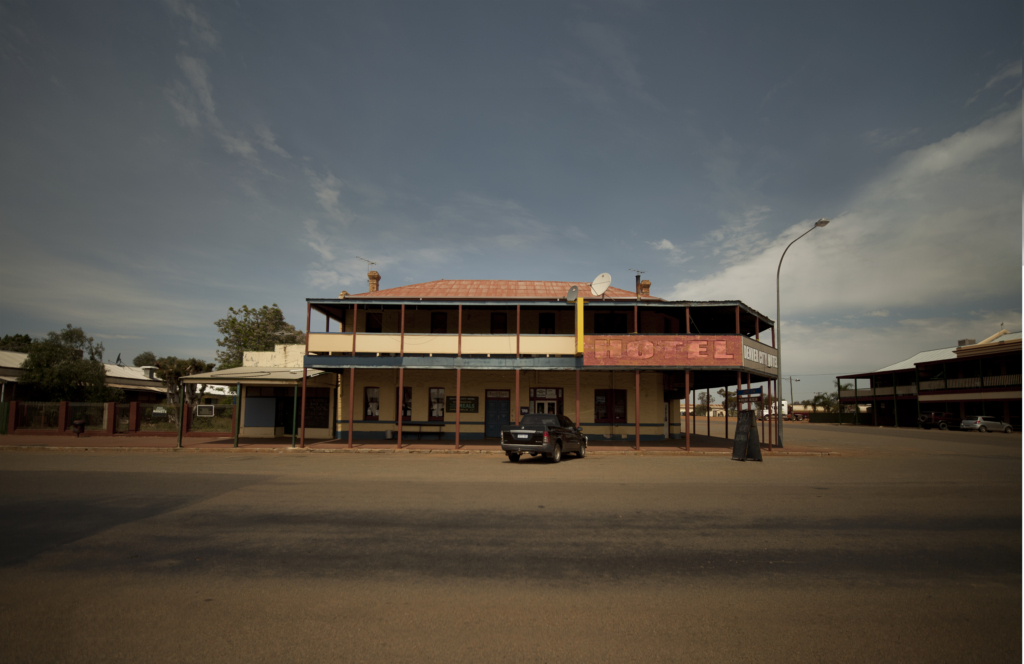
Reality kicks in fast on their arrival at the Denver City Hotel. Alarm bells start to ring following the sight of a chalkboard outside the pub, tilted towards motorists, reading, ‘NEW GIRLS TONITE!!’ Following Hotel Coolgardie’s international festival run, one overseas critic drew a parallel with Greg McLean’s Australian Gothic film Wolf Creek (2005), describing the doco as ‘a real-life backpacker horror story’.[3]Maurie Alioff, ‘Review: Hotel Coolgardie’, Point of View, 29 April 2016, <http://povmagazine.com/articles/view/review-hotel-coolgardie>, accessed 31 October 2016. The torture endured by Lina and Steph is not physical, however. To say sexual harassment and humiliation are par for the course in their new job is an understatement – the women are expected to be geishas more than bartenders. ‘Fresh meat!’ says one drinker. Another straight-up asks for sex, then adds, ‘It will be very quick, so it’s not so much of a problem,’ in a loud, slow, I’m-speaking-to-a-foreigner manner. As Hotel Coolgardie shows, these blokes are rough as hell. Ruddy-faced, slurry-sentenced and fluoro-vested, many of them are fly-in-fly-out miners, and the rest are lifelong locals. Their attitude towards women – particularly foreign women – is that they are an essentially different species. Lina and Steph’s boss is the worst of all: undermining, cruel and unsympathetic to the cultural differences that make it hard for them to discern the broad Australian accent or a draught from a bitter.
Lina, the smarter and more sensitive of the two, is in tears by the end of their first night. They’ve made a terrible mistake, she recounts, but are committed to the job for three months. Steph refuses to play the game of flirting and flattering her boss and his patrons. She endures by rolling her eyes and receding into teenager-like quietude. They are meant to laugh off abuse, be good girls, duck and weave through constant bombardment. In the microcosm of this tiny corner pub, the exhaustion and performance of that default, defensive mode of women’s lived experience forms the basis of the film’s subtle assessment of the gender politics of small-town life.
In the microcosm of this tiny corner pub, the exhaustion and performance of that default, defensive mode of women’s lived experience forms the basis of the film’s subtle assessment of the gender politics of small-town life.
The 2011 Foxtel series Kalgoorlie Cops offers a more sensationalised outlook on similar subject matter. The eight-part factual program, which aired on the Crime & Investigation Network, bills the region as ‘Australia’s Real Wild West’, conjuring a world of high-speed highway chases, resilient good-bloke police, gold theft and bikie outlaws – true stories edited into tight, episodic output. Although Hotel Coolgardie’s production values are similarly televisual rather than cinematic, its focus is smaller and odder: through the eyes of outsiders, we get fresh access to an intensely blokey culture, linking the personal experiences of Lina and Steph with a larger social reality.
Thematically, the documentary’s closest cinematic precedent is the great classic Wake in Fright, and this fact suggests that little has changed in rural Australia since that film’s debut in 1971. Director Ted Kotcheff took inspiration from Kenneth Cook’s eponymous 1961 novel in summoning a picture of Australia as an alcohol-fuelled nightmare – a description that, arguably, applies to what it is today.[4]In Australia, ‘[e]xcessive alcohol consumption is a cause of a wide range of health and other harms including being the major cause of road and other accidents, domestic and public violence, crime, liver disease and brain damage, and contributes to family breakdown and broader social dysfunction’; see ‘Alcohol and Health in Australia’, National Health and Medical Research Council, Australian Government, 14 April 2015, <https://www.nhmrc.gov.au/health-topics/alcohol-guidelines/alcohol-and-health-australia>, accessed 31 October 2016. Like Hotel Coolgardie, Wake in Fright required the involvement of an outsider for its critique to be made – Kotcheff is Canadian – enabling an impartiality with which to observe the culture of aggressive mateship, gambling and easy violence. In the world of Kotcheff’s film, the consequence of these things is only ever psychological: a dawning, shaming realisation of the previous night’s insanity. Though often incorrectly billed as a horror, the drama explores only the mundane horrors of everyday Australia – in particular, many straight men’s greatest fear of sex with other men. For that reason, women appear only peripherally in Wake in Fright, as luring and needy sexual beings, completely disempowered and secondary to the hectoring bonds between the male characters.
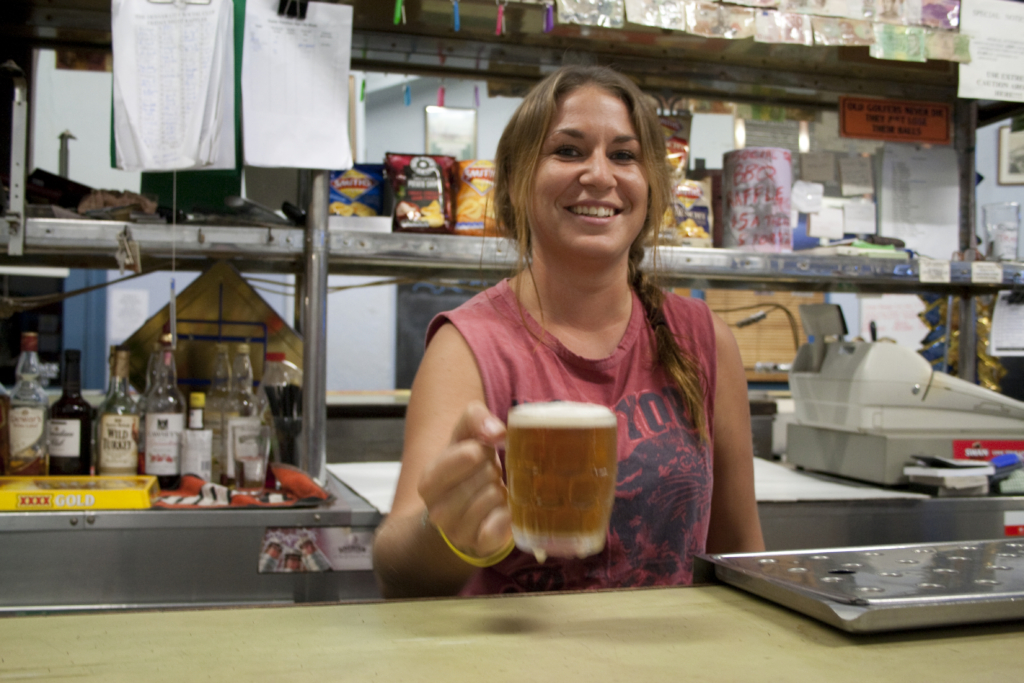
There is something similar at play with Hotel Coolgardie’s women. We get the sense that the previous bartenders, from Wales, have been pulled into the madness of the town – everything normalised. Rather than leaving straightaway at the end of their tenure, the pair party for a few days, dancing on the bar and tolerating physical advances – really, sexual assaults – from the local blokes, with faux outrage. Lina and Steph, in contrast, are outwardly appalled. As the documentary meanders through their time in Coolgardie, they initiate tentative friendships with peripheral but important characters. The first is with Anthony, one of the younger, less Wolf Creek–ish local boozers, who has a university education. The second is with Canman, an eccentric elderly man who is so nicknamed for his habit of collecting the pub’s empty beer cans for redemption at the local recycling plant, one carload recompensing a measly A$88. Perhaps thinking of his own estranged daughter, Canman makes a habit of bringing Lina and Steph sweet, strange, daily gifts of plastic bracelets and Bacchus Cowgirl Smoothies.
Generically, Hotel Coolgardie belongs to the long tradition of observational documentaries. The nature of this film’s fly-on-the-wall production is clear to the viewer, the images we see resembling home videos as we swoop our necks around the pub and watch Lina and Steph manning beer tap handles. US film critic and theorist Bill Nichols writes that the observational mode ‘stresses the nonintervention of the filmmaker’,[5]Bill Nichols, Representing Reality: Issues and Concepts in Documentary, Indiana University Press, Bloomington & Indianapolis, 1991, p. 38. who attempts simply to capture a commonplace milieu as naturally as possible, then subsequently edits without the overt constructedness of documentary conventions like re-enactments, talking heads or voiceovers. At SFF, Gleeson corroborated this categorisation, explaining:
We were in a pub, so we had to be nimble and ready for anything. The crew was just myself, my producer, my cameraperson and my sound person. We were embedded, we stayed upstairs with the girls, and we were there 24/7.
For observational filmmakers, this unobtrusive embeddedness can be a strength or a weakness. A common pitfall of the observational documentary is that much material can be collected and presented without a clear sense of directorial perspective. In Hotel Coolgardie, the material is rich, but a passive storytelling approach towards disquieting subject matter has resulted in a tonal ambiguity between comedy and drama. While viewing, it is often difficult to know how to feel, particularly with the locals’ sexual harassment occasionally played for laughs and with upbeat acoustic guitar music accompanying the most rowdy interior pub scenes.
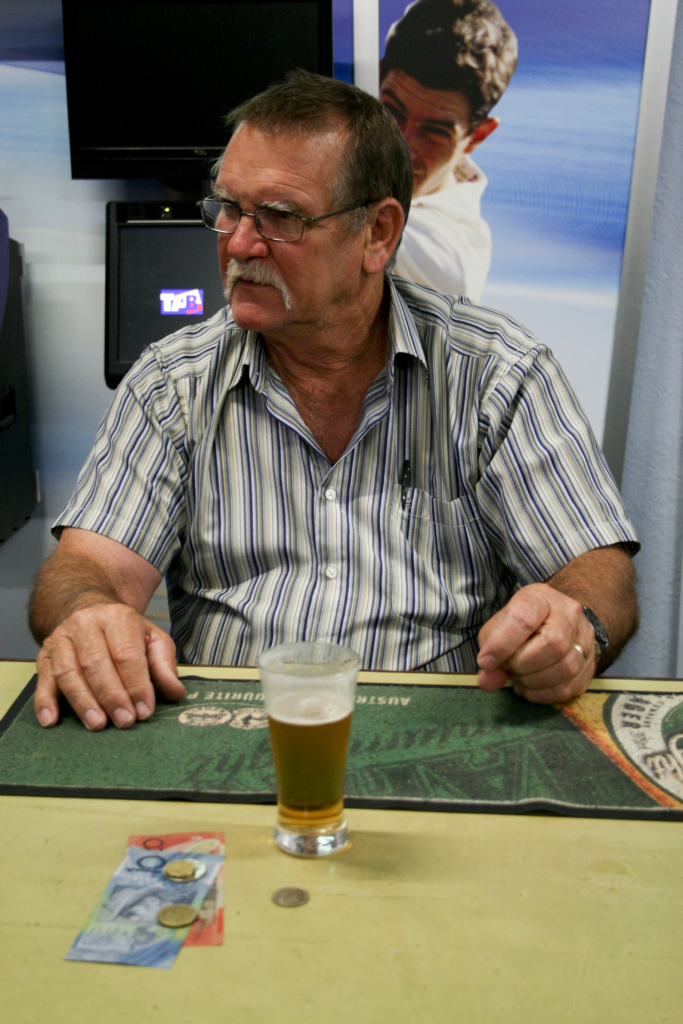
Far from condemning the town’s male characters as evil misogynists, Gleeson aims for more complex characterisations while never losing sight of the fact that the blokes undoubtedly occupy the position of privilege in Coolgardie. In an interview with ABC News, Gleeson says the film expresses not only what it means to be ‘an outsider, but what it means to be part of the dominant culture or majority and what responsibility that might entail’.[6]Pete Gleeson, quoted in Sam Tomlin, ‘Director Defends Controversial Documentary on “Backpacker Nightmare” at Coolgardie Pub’, ABC News, 9 June 2016, <http://www.abc.net.au/news/2016-06-09/filmaker-defends-controversial-goldfields-documentary/7496856>, accessed 31 October 2016. The blokes, particularly Anthony and Canman, are portrayed both as predators and as victims of their own undereducation and ineptitude when relating to women. One punter even says he has never had a relationship with a woman, and doesn’t know how to talk to them. Though the field of action is murky, the film should naturally lend itself to a feminist reading. Gleeson, however, stays close to the observational-documentary mandate of stringent non-interference. The scenes unfold in a muddy zone of dark humour and reasoned distance, the filmmaker less interested in making a particular statement about sexism and misogyny, than in creating an immersive view of life in a strange, small town. Despite the obvious us-versus-them mentality of Coolgardie’s men, and the moral revulsion the audience might feel from seeing brazen assault after brazen assault, Gleeson approaches them with compassion.
All filmmaking, even in the documentary realm, necessarily involves interference; through the processes of producing, shooting, editing and even casting (Lina and Steph are indeed characters in a narrative arc, despite their existence in the world outside the film), every filmmaker is making decisions about what to present and how to present it. Like all observational documentaries, Hotel Coolgardie utilises any number of storytelling conventions to construct what we see: narrative structure, characterisation, digressive subplots, unscripted dialogue and handheld camera work form part of a visual anti-aesthetic that is designed to give an impression of rough, ready-made honesty. The issue is whether it admits its own artificiality, its own constructedness.
Far from condemning the town’s male characters as evil misogynists, Gleeson aims for more complex characterisations while never losing sight of the fact that the blokes undoubtedly occupy the position of privilege in Coolgardie.
More underyling is the question of how much interference – how much shaping and moulding – is legitimate, without resorting to manipulation, exploitation or the subversion of the subjects’ desires and personalities. Observational documentary–making involves its own sets of interferences, and, perhaps in an effort to avoid didacticism, Gleeson has decided not to craft an overtly feminist message from his filmmaking materials. Because all filmmakers, even observational ones with a fly-on-the-wall approach, are not just witnessing but crafting stories, Gleeson’s open-ended, uncommentated approach to depicting sexism is in itself a creative and political decision. One presumes the director’s aim is for the commentary to lie subtly underneath the character studies, but the result is often a lack of clarity in an already morally murky space.
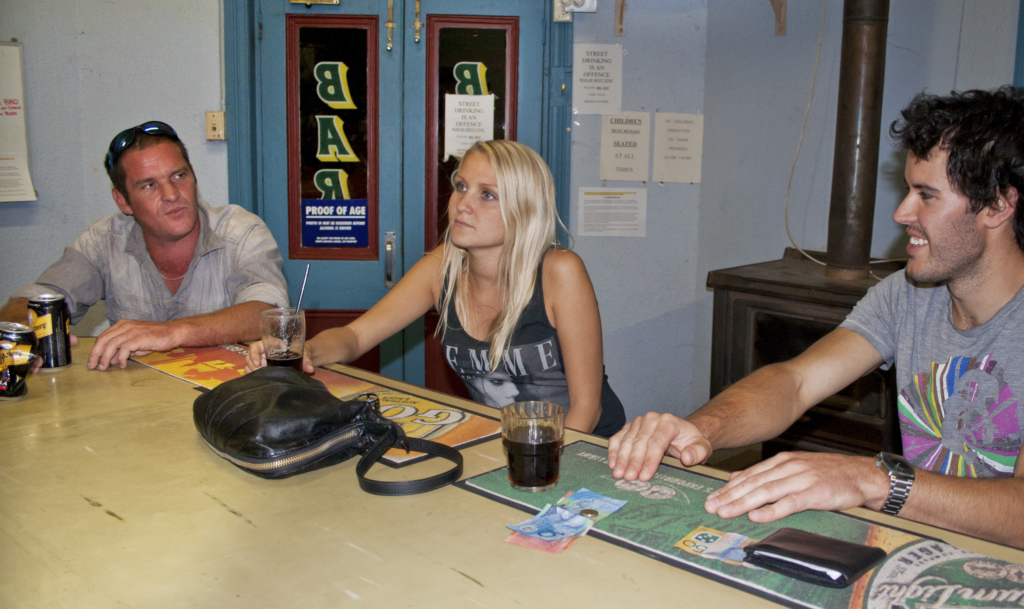
In light of Gleeson’s creative policy of non-interference, Hotel Coolgardie’s most piercing insight comes from Lina. The sunset shot is potentially iconic: she is on the long, deep corner verandah of the pub – the kind of timber overhang many Australians would be familiar with, the kind of outlook present in every town. Looking past the faceless man behind the camera, she watches a truck barrel through the town and remarks on the despondence of the place: ‘People here aren’t clinically depressed; they’re just sad.’ Perhaps white men’s disempowerment within their own dominant culture is the film’s hidden refrain. Here, we can infer a message about what that sadness encompasses – the loneliness of a straight male life without female intimacy; the void left by a society without a dating culture; the sadness of sexism for women and men; the notion that nobody ultimately benefits emotionally from a gender-divided world, and that breaking those divides is in everyone’s interests; the poison of alcohol as a lifeline in socially remote communities; and the relationship between isolation and mental illness, with rural men experiencing suicidality at a greater rate than their metropolitan counterparts.[7]Susan Beaton, ‘Insights into Men’s Suicide’, InPsych, August 2012, available at Australian Psychological Society website, <https://www.psychology.org.au/inpsych/2012/august/beaton/>, accessed 31 October 2016. With so little expository content, Lina’s comment is the closest the documentary ever comes to enunciating a theme.
That such an expression of compassion comes from the very recipient of so much abuse is testament to the power of observational documentary as a cinematic form: it demonstrates how a film’s subjects can be stronger on their own, without a narrator or a visible on-screen role for the director. This power also lies in the rejection of a didactic message-conveyer approach, as well as in the collection of abundant ‘real-world’ material, the directness of the fly-on-the-wall sensibility, and the notion that a subject’s voice is more robust when witnessed by an audience. Gleeson has handed over his authorial voice to his subjects; the documentary allows viewers to hear those voices and interpret them as they wish.
http://www.hotelcoolgardiethefilm.com
Endnotes
| 1 | See the Australian Institute of Aboriginal and Torres Strait Islander Studies map of Indigenous Australia, <http://aiatsis.gov.au/explore/articles/aiatsis-map-indigenous-australia>, accessed 4 November 2016. |
|---|---|
| 2 | See Natasha Bita, ‘Working Visas Granted to Increasing Number of Backpackers’, News.com.au, 27 August 2013, <http://www.news.com.au/finance/work/working-visas-granted-to-increasing-number-of-backpackers/story-e6frfm9r-1226705207442>, accessed 31 October 2016. |
| 3 | Maurie Alioff, ‘Review: Hotel Coolgardie’, Point of View, 29 April 2016, <http://povmagazine.com/articles/view/review-hotel-coolgardie>, accessed 31 October 2016. |
| 4 | In Australia, ‘[e]xcessive alcohol consumption is a cause of a wide range of health and other harms including being the major cause of road and other accidents, domestic and public violence, crime, liver disease and brain damage, and contributes to family breakdown and broader social dysfunction’; see ‘Alcohol and Health in Australia’, National Health and Medical Research Council, Australian Government, 14 April 2015, <https://www.nhmrc.gov.au/health-topics/alcohol-guidelines/alcohol-and-health-australia>, accessed 31 October 2016. |
| 5 | Bill Nichols, Representing Reality: Issues and Concepts in Documentary, Indiana University Press, Bloomington & Indianapolis, 1991, p. 38. |
| 6 | Pete Gleeson, quoted in Sam Tomlin, ‘Director Defends Controversial Documentary on “Backpacker Nightmare” at Coolgardie Pub’, ABC News, 9 June 2016, <http://www.abc.net.au/news/2016-06-09/filmaker-defends-controversial-goldfields-documentary/7496856>, accessed 31 October 2016. |
| 7 | Susan Beaton, ‘Insights into Men’s Suicide’, InPsych, August 2012, available at Australian Psychological Society website, <https://www.psychology.org.au/inpsych/2012/august/beaton/>, accessed 31 October 2016. |
